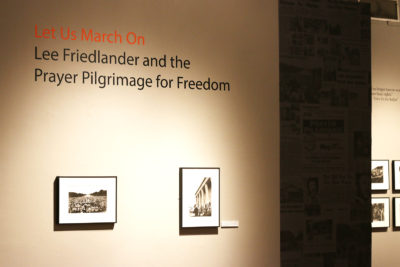
Pictures of Ferguson, Missouri hang alongside stills of peaceful protest in Washington, D.C.
Boston University Art Galleries’ new exhibition, “Let Us March On: Lee Friedlander and the Prayer Pilgrimage for Freedom” presents the work of photographer Lee Friedlander who covered an often forgotten civil rights march in 1957.
The exhibition is on display at BU’s Faye G., Jo, and James Stone Gallery. The march, held on the third anniversary of the Brown v. Board of Education court case that made the segregation of public schools illegal, is considered a precursor to the 1963 March on Washington.
Friedlander’s photos include a predominantly African-American crowd at the Lincoln Memorial in Washington, D.C. watching Martin Luther King Jr. give his first national address. Other civil rights leaders such as Mahalia Jackson, Roy Wilkins and Mordecai Johnson were present at the event.
The images are paired with the art of three contemporary photographers, whose work highlights the ongoing fight for racial equity. Nancy Musinguzi, a Minneapolis-based artist, created some contemporary pieces on display at the exhibition.
“Lee Friedlander’s work is really good content to start that conversation around,” Musinguzi said. “How do we remember our past, and how does that shape our present and our future as a consequence of how we’ve learned or treated these past events? Not as relics but as a continual experience that takes different forms in the now.”
The three artists whose works accompany Friedlander’s focus on the Black Lives Matter movement and civil unrest of the last decade.
One of Musinguzi’s photos shows two young black children in a protest on the two year anniversary of Eric Garner’s death. The photo was originally published by The New York Times and later selected for the exhibition.
Musinguzi drew parallels between Friedlander’s work and her own, but said she wanted to showcase different emotion.
“The work is beautiful, but I don’t want to keep photographing people in pain and struggle,” Musinguzi said. “I want to show people that look like me in a different light.”
Whitney Curtis, a St. Louis-based artist, also created pieces on display at the exhibition. Curtis’s photographs of the riots in Ferguson, Missouri in 2014 hang side-by-side with the peaceful protest of 1957.
“One of my takeaways photographing the protest in Ferguson is how to me, it felt like a protest that was women led,” Curtis said. “African-American women were at the forefront, and … they came together and collaborated with each other.”
The predominance of women of color was described by The Los Angeles Times in an article following the protests. Describing the situation in Ferguson, the article also said, “many women will be behind the protest bullhorns in the days and weeks ahead.”
Curtis spoke about her potential bias as a white woman and the importance of objectivity. The artists displaying work at the exhibition comprise a group including perspectives from black men, black women and white women.
To compliment Friedlander’s peaceful protesters and photos of some of the harsher realities of 21st century racial controversies, Artist Sheila Pree Bright wanted to display the people protestors were fighting for.
“In my work, and being on the ground, I didn’t want to show what the media showed of black people,” Bright said. “There’s the stereotype of the angry black man, so I showed instead a man with tears running down his face. I wanted to show the humanity of blacks. We are not disposable.”
All of the art on display shows perspectives from different eras, places and types of people around the country, engaging with a movement which unifies them all. The exhibition will be on display through March 25.
“Through art, I call it art activism,” Bright said. “I believe hopefully we can come together and start having critical dialogue about what’s going on in this country. … It’s time.”

















































































































